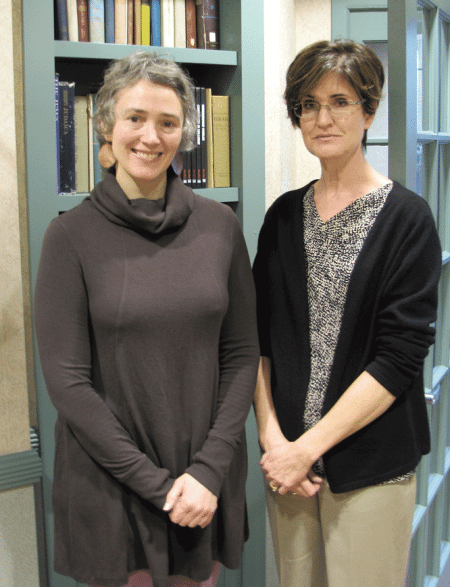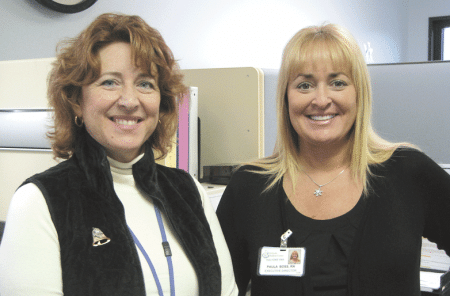Making the Days Count
Hospice Brings Quality of Life to Dying Patients, Families

Sarah Jackson, left, and Carol Lewis say the team aspect of hospice care is one of its most important features.
“Hospice simply gives people more support toward the end of life,” said the volunteer coordinator for Holyoke VNA & Hospice Life Care. “It’s not giving up; it’s changing the way we look at life. Do you want to go to your beach house one last time? Do you want to go see the Red Sox? We’re really focusing on quality of life, not how many days, weeks, or months you have left. The perspective changes; what’s really important to you? Because now is the time to do it.”
In short, families that choose hospice care for their dying loved ones “aren’t throwing their hands in the air. They’re saying, ‘this is what’s really important to us.’ A lot of times, that’s just spending time together as a family, saying the things they need to say.”
Most hospice programs follow the same format, Hennessey told BusinessWest. “The family and the patient generally meet with their physician about the diagnosis they have, and the physician has to certify that they have less than six months to live if the disease follows its normal prognosis. When we get the referral, we can admit them to hospice.”
It’s also a team approach to care. “Every patient gets a hospice nurse. They can also have a social worker if they’d like, a home health aide, or volunteer services if they choose. On top of that, we have other complementary services; we have a therapeutic heart program, a harpist to play at the bedside for the patient, and a pet therapist who visits patients in nursing facilities. I have a couple of volunteers who practice Reiki and energy work; we can offer that to patients as well.”
Carol Lewis, director of hospice at Spectrum Home Health and Hospice Care in Longmeadow, explained that “we’re looking for patients who have a terminal diagnosis that requires symptom management by nurses who have expertise in that area, and are educated in taking care of the holistic needs of that community. That’s the broad picture of what we do.”
She also stressed the team aspect of hospice care. “That’s the unique aspect of it; it’s a team of trained professionals that address these needs, and it’s not only about the patient, but supporting the family as well.”
For this issue’s focus on the business of aging, BusinessWest takes a look at an area of healthcare that has been growing in prominence as America’s 65+ demographic soars to record numbers — and the many ways hospice care is providing, if not hope for recovery, a measure of peace and acceptance for those approaching the very end of life.
Rising Tide
Indeed, 2009 saw 1,341,391 patients access hospice care; last year, that figure had risen to 1,542,737, a 15% increase.
There’s some statistical evidence that palliative, or comfort-only, care brings real benefits to the dying or critically ill. A study several years ago at Massachusetts General Hospital divided a group of stage 4 lung cancer patients into two groups; all of them received traditional chemotherapy through a physician, but half also enjoyed the services of a palliative care team.
The results, published in the New England Journal of Medicine, showed a measurable difference in the amount of anxiety and depression, while patients who had received palliative care from the start averaged a three-month survival advantage.
While some palliative care includes curative treatment, however, hospice is reserved for patients who forgo all but comfort-centered care; in other words, they’re no longer fighting to get better.
Sarah Jackson, executive vice president of Spectrum, explained that patients can receive hospice care in any community setting.
“Wherever you are, you can select a hospice benefit,” added Paula Boss, executive director of Holyoke VNA & Hospice Life Care. “At home, a nursing home, assisted living, a friend’s home — you can receive hospice care.”
At the heart of hospice care, Hennessey said, is a cadre of volunteers who spend time with the patient, particularly when their loved ones aren’t able to do so.

Leslie Hennessey, left, and Paula Boss say hospice services are available to patients wherever they live, whether at home or in a community care setting.
She said Holyoke’s volunteers hail from all walks of life. “A lot of folks have had experience with hospice in the past and loved ones in a hospice program, and they felt like they wanted to give something back; they realized how important it was, that extra support, how much they appreciated it, and they want to do that for another family.”
Hennessey said she conducts trainings twice a year for people who want to help in this manner. “Sometimes they say, ‘I don’t know if I can do this, but I want to try.’ They’re very special people.”
After all, she noted, “if you’re a hospice volunteer, you have to understand that every patient will die. That’s what we tell them on the phone before we even send them the information packet; I need them to know that every person they meet will die, and I ask, ‘how do you feel about that?’ It’s something they really need to consider. They know what they’re getting into when they walk through that door. They’re amazing.”
Lewis said Spectrum’s program also offers the services of a harpist with a degree in thanatology, the study of death, as well as service dogs that provide comfort to patients and their families.
“We also have a chaplain as part of the team,” she said. “When I say holistic care, I mean we meet physical needs, emotional needs, and more. Sometimes the chaplain is looking at some life review with the patient and the meaning of life, providing some comfort, or maybe just some reading at the bedside.”
Whether it’s the nurse, social worker, home health aide, chaplain, or volunteer at the bedside — and families can call for help 24/7 — hospice care is just as much a benefit for the family as it is for the patient, Jackson said. “We can be helpful for families, giving the caregiver a little bit of respite, by sitting vigil with their loved ones, having a volunteer come in for an hour or two so the family can take a break.”
At the same time, Lewis said, hospice staff takes time to educate the family so they can provide more effective care when hospice workers and volunteers aren’t nearby. “That really helps in the grief process, to look back and know you helped provide the comfort.”
Typically, hospice care includes a full year of grief counseling for the family after the patient dies, Boss said. “Often, the grief really hits them after the funeral, and they have continuing needs.”
Setting the Record Straight
Lewis said families often have misconceptions about what it means to elect hospice care. For instance, “a lot of people think they can never go to the hospital. But any time they need a level of care that isn’t offered in hospice, an emergency situation where they might need short-term help, they can go to the hospital.”
Also, Boss noted, “some people think they don’t receive any medication anymore, but that’s not the case. Yes, we often discontinue medications that are not needed for comfort or pain. But some cancer patients receive chemotherapy if there’s a comfort purpose and not a treatment purpose. We’re very strong on keeping people comfortable.”
Hennessey told BusinessWest that hospice benefits are typically covered by Medicare and Medicaid, as well as most private payers. “It’s not always something you’re looking for in your benefit package when you sign up, but most insurances have a hospice benefit, and it can be a huge benefit to families.”
The question for those families is when to take that step and admit that quality of life is more important than fighting an uphill battle for recovery. The growing ranks of older Americans have made end-of-life care a hot topic these days, and a tricky one.
That’s because, while doctors can extend life, often by artificial means, to a greater degree than ever, that intervention is often prohibitively expensive, and the quality of that life often dubious. So, increasingly, patients, families, and caregivers face hard questions — not about whether doctors can add weeks, months, or years to the life of a dying patient, but about whether they should.
“Awareness of hospice has increased, but barriers are still there — a lot of cultural barriers,” Boss told BusinessWest. “Some cultures really don’t understand the hospice benefit; they don’t understand all the things we can bring to them. There’s still a long way to go. A large number of patients are eligible to benefit from hospice, but never elect it.”
Hennessey cited a statistic that about 21,000 patients receive hospice care annually in Massachusetts, about 40% of all deaths. “It’s a good number, but it would be great if it was all patients, or close to 80% of patients.”
She also noted that the median length of hospice care is only 23 days, which means patients and families are often opting for it much later than they’re eligible. “We’re working with doctors and facilities to identify folks who could really benefit from these programs,” she said. “The benefit is for a life expectancy of six months, but in 23 days, we’ve just got things arranged, and then, unfortunately, we lose the patient.”
Lewis agreed. “Unfortunately, some families wait until the very end to contact hospice, but we’re able to get involved six months before the end, when there’s time to develop relationships with the team and to provide quality of life while the person is still here.
“It’s a chicken-and-egg situation,” she added. “A lot of times, people call us at the end, so the community sees us coming at the end and think we’re heavily associated with the end of life. But it’s earlier in the process that hospice really has its true benefit.”
So hospice advocates continue to get the word out to doctors and the public.
“It’s not giving up hope, throwing your hands up, saying, ‘I can’t cure this,’” Hennessey said. “I want to put you in the hands of people who can manage your pain symptoms so you can get the best life you can out of your last months.’”
Joseph Bednar can be reached at [email protected]





